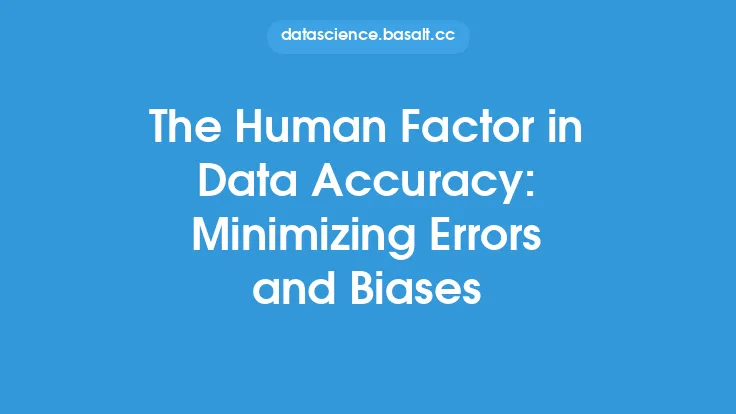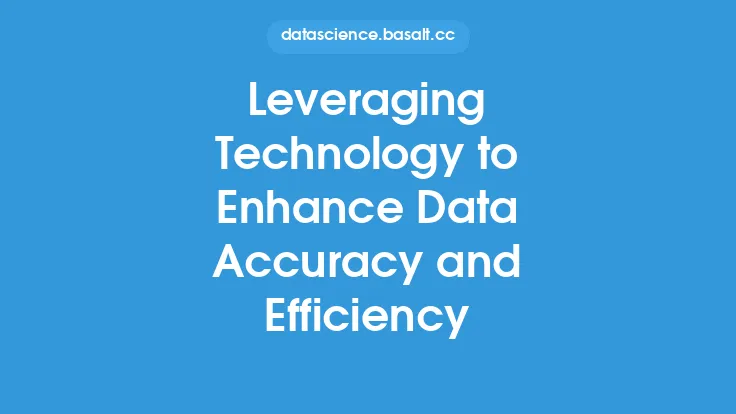Measuring and evaluating data quality is a crucial step in ensuring that data is accurate, reliable, and usable for decision-making purposes. Data accuracy metrics are used to assess the quality of data and identify areas where improvements can be made. In this article, we will delve into the different types of data accuracy metrics, how to calculate them, and how to use them to evaluate data quality.
Introduction to Data Accuracy Metrics
Data accuracy metrics are quantitative measures used to evaluate the accuracy of data. These metrics can be used to assess the quality of data in various domains, including business, healthcare, finance, and more. Data accuracy metrics can be categorized into several types, including:
- Accuracy metrics: These metrics measure the degree to which data values are correct and consistent with the true values.
- Completeness metrics: These metrics measure the degree to which data is complete and free from missing values.
- Consistency metrics: These metrics measure the degree to which data is consistent across different datasets and systems.
- Timeliness metrics: These metrics measure the degree to which data is up-to-date and relevant.
Types of Data Accuracy Metrics
There are several types of data accuracy metrics, each with its own strengths and weaknesses. Some of the most common data accuracy metrics include:
- Precision: This metric measures the number of true positives (correctly predicted values) divided by the total number of predicted values.
- Recall: This metric measures the number of true positives divided by the total number of actual positive values.
- F1-score: This metric is the harmonic mean of precision and recall, providing a balanced measure of both.
- Mean Absolute Error (MAE): This metric measures the average difference between predicted and actual values.
- Mean Squared Error (MSE): This metric measures the average squared difference between predicted and actual values.
- Root Mean Squared Error (RMSE): This metric is the square root of MSE, providing a more interpretable measure of error.
Calculating Data Accuracy Metrics
Calculating data accuracy metrics involves several steps, including:
- Data collection: Gather the data to be evaluated, including the predicted values and actual values.
- Data preprocessing: Clean and preprocess the data to ensure it is in a suitable format for calculation.
- Metric selection: Choose the relevant data accuracy metric(s) to calculate, based on the specific use case and requirements.
- Calculation: Calculate the chosen metric(s) using the collected and preprocessed data.
- Interpretation: Interpret the results, taking into account the strengths and weaknesses of each metric.
Evaluating Data Quality using Data Accuracy Metrics
Evaluating data quality using data accuracy metrics involves several steps, including:
- Setting thresholds: Establish thresholds for each metric, based on the specific use case and requirements.
- Comparing results: Compare the calculated metric values to the established thresholds.
- Identifying areas for improvement: Identify areas where the data quality is below the threshold, and prioritize improvements accordingly.
- Implementing improvements: Implement changes to improve data quality, such as data cleansing, data validation, or data normalization.
- Monitoring progress: Continuously monitor data quality using data accuracy metrics, and adjust improvements as needed.
Challenges and Limitations of Data Accuracy Metrics
While data accuracy metrics are essential for evaluating data quality, there are several challenges and limitations to consider, including:
- Data quality issues: Poor data quality can lead to inaccurate or misleading metric values.
- Metric selection: Choosing the wrong metric can lead to incorrect conclusions about data quality.
- Threshold setting: Establishing appropriate thresholds can be challenging, especially in complex datasets.
- Interpretation: Interpreting metric results requires expertise and understanding of the underlying data and use case.
Best Practices for Using Data Accuracy Metrics
To get the most out of data accuracy metrics, follow these best practices:
- Use multiple metrics: Calculate and evaluate multiple metrics to get a comprehensive understanding of data quality.
- Establish clear thresholds: Set clear and relevant thresholds for each metric, based on the specific use case and requirements.
- Continuously monitor: Continuously monitor data quality using data accuracy metrics, and adjust improvements as needed.
- Consider data context: Consider the context in which the data is being used, and choose metrics and thresholds accordingly.
- Document and communicate: Document and communicate data accuracy metric results and improvements to stakeholders, to ensure transparency and accountability.





